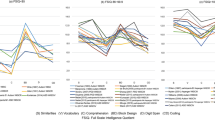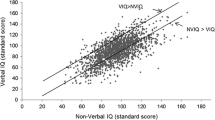Abstract
Although previous research helped to define differences in intelligence between neurotypicals and those with ASD, results were limited by small sample sizes or restricted subtests. Using data from the NIMH Data Archive, this study examined the intelligence of children with ASD (N = 671). Results demonstrate an average standard deviation of 25.75, which is 1.72 times greater than that of the normative sample for the WISC-III. Moreover, students with ASD are 12 times more likely than the general population of students to score within the intellectual disability range, but are also 1.5 times more likely to score in the superior range, suggesting that more students with ASD should be considered for giftedness. Determining the diversity of intelligence among those with ASD has implications for research, clinical practice, and neurological understanding.

Similar content being viewed by others
References
Kanner L (1943) Autistic disturbance of affective contact. Nerv Child 2:217–250
Harris J (2018) Leo Kanner and autism: a 75-year perspective. Int Rev Psychiatry 30:3–17
American Psychiatric Association (2013) Diagnostic and statistical manual of mental disorders, 5th edn. American Psychiatric Association, Washington
Wozniak RH, Leezenbaum NB, Northrup JB, West KL, Iverson JM (2017) The development of autism spectrum disorders: variability and causal complexity. Wiley Interdiscip Rev Cog Sci 8:1426
Center for Disease Control and Prevention (CDC) (2020) Data and Statistics on Autism Spectrum Disorder. https://www.cdc.gov/ncbddd/autism/data.html
de Martínez-Pedraza FDL, Carter AS (2009) Autism spectrum disorders in young children. Child Adolesc Psychiatric Clin 18:645–663
Caemmerer JM, Keith TZ, Reynolds MR (2020) Beyond individual intelligence tests: application of Cattell–Horn–Carroll theory. Intelligence 79:01433
Froiland JM (2018) Intelligence Quotient (IQ). In: Frey B (ed) SAGE Encyclopedia of Educational Research, Measurement, and Evaluation. SAGE, London
Sattler JM, Shaw, SR, & Dumont R (2018) Wechsler intelligence scale for children: 5th edition integrated. Resource guide to accompany assessment of children: Cognitive foundations and applications (6th edition)
Froiland JM, Davison ML (2020) Social perception: relationships with general intelligence, working memory, processing speed, visual-spatial ability, and verbal comprehension. Ed Psychol 40:750–766
Villeneuve EF, Hajovsky DB, Mason BA, Lewno BM (2019) Cognitive ability and math computation developmental relations with math problem solving: An integrated, multigroup approach. Sch Psychol 34:96
Lubinski D (2009) Exceptional cognitive ability: The phenotype. Beh Genet 39:350–358
Canivez GL, Watkins MW, Dombrowski SC (2017) Structural validity of the Wechsler Intelligence Scale for Children-Fifth Edition: Confirmatory factor analyses with the 16 primary and secondary subtests. Psychol Assess 29:458–472
Dombrowski SC, Canivez GL, Watkins MW, Beaujean AA (2015) Exploratory bifactor analysis of the Wechsler Intelligence Scale for Children—Fifth Edition with the 16 primary and secondary subtests. Intelligence 53:194–201
Watkins MW, Canivez GL (2021) Assessing the psychometric utility of IQ scores: A tutorial using the Wechsler intelligence scale for children–fifth edition. Sch Psychol Rev
Mayes SD, Calhoun SL (2008) WISC-IV and WIAT-II profiles in children with high-functioning autism. J Autism Dev Disord 38:428–439
Shaw SR, Jankowska AM (2018) Pediatric intellectual disabilities at school: Translating research into practice. New York, US
Flynn JR (2006) Tethering the elephant: Capital cases, IQ, and the Flynn effect. Psychol Pub Pol’y & L 12:170–189
Trahan LH, Stuebing KK, Hiscock M, Fletcher JM (2014) The Flynn effect: A meta-analysis. Psychol Bull 140:1332–1360
O’Riordan MA, Plaisted KC, Driver J, Baron-Cohen S (2001) Superior visual search in autism. Journal Exp Psychol Hum Percept Perform 27:719
Pellicano E, Burr D (2012) When the world becomes ‘too real’: a Bayesian explanation of autistic perception. Trends Cogn Styles 16:504–510
Remington A, Fairnie J (2017) A sound advantage: Increased auditory capacity in autism. Cognition 166:459–465
Shah A, Frith U (1993) Why do autistic individuals show superior performance on the block design task? J Child Psychol Psychiatry 34:1351–1364
Tillmann J, Swettenham J (2017) Visual perceptual load reduces auditory detection in typically developing individuals but not in individuals with autism spectrum disorders. Neuropsychology 31:181–190
Happé F (1999) Autism: cognitive deficit or cognitive style? https://www.ncbi.nlm.nih.gov/pubmed/10354574
Tesfaye R, Courchesne V, Yusuf A, Savion-Lemieux T, Singh I, Shikako-Thomas K et al (2019) Assuming ability of youth with autism: synthesis of methods capturing the first-person perspectives of children and youth with disabilities. Autism 23:1882–1896
Charman T, Pickles A, Simonoff E, Chandler S, Loucas T, Baird G (2011) IQ in children with autism spectrum disorders: data from the Special Needs and Autism Project (SNAP). Psychol Med 41:619–627
Baio J, Wiggins L, Christensen DL, Maenner MJ, Daniels J, Warren Z et al (2018) Prevalence of autism spectrum disorder among children aged 8 years—autism and developmental disabilities monitoring network, 11 sites, United States, 2014. MMWR Surveill Summ 67:1
Billeiter KB, Froiland JM, Allen JP, Hajovsky DB (2021) Neurodiversity and Intelligence: evaluating the flynn effect in children with autism spectrum disorder. Child Psychiatry Hum Dev
Benson NF, Kranzler JH (2018) Another look at the construct validity of the gifted rating scales: preschool/kindergarten and school forms. J Psychoeduc Assess 36:782–797
Office for Civil Rights: U.S. Department of Education (2021) https://www2.ed.gov/about/offices/list/ocr/index.html
Karnes FA, Shaunessy E (2004) Gifted students with disabilities: are we finding them? Gift Child Today 27:16–21
Crespi BJ (2016) Autism as a disorder of high intelligence. Front Neurosci 10:300
Ha S, Sohn IJ, Kim N, Sim HJ, Cheon KA (2015) Characteristics of brains in autism spectrum disorder: structure, function and connectivity across the lifespan. Exp neurobiol 24:273–284
Lord C, Elsabbagh M, Baird G, Veenstra-Vanderweele J (2018) Autism spectrum disorder. Lancet 392:508–520
Courchesne E, Campbell K, Solso S (2011) Brain growth across the life span in autism: age-specific changes in anatomical pathology. Brain res 1380:138–145
Buxhoeveden DP, Casanova MF (2002) The minicolumn hypothesis in neuroscience. Brain 125:935–951
Happé F, Frith U (2006) The weak coherence account: detail-focused cognitive style in autism spectrum disorders. J Autism Dev Disord 36:5–25
Coolican J, Bryson SE, Zwaigenbaum L (2008) Brief report: Data on the Stanford-Binet intelligence scales in children with autism spectrum disorder. J Autism Dev Disord 38:190–197
Eussen ML, Van Gool AR, Verheij F, De Nijs PF, Verhulst FC, Greaves-Lord K (2013) The association of quality of social relations, symptom severity and intelligence with anxiety in children with autism spectrum disorders. Autism 17:723–735
Wechsler D (1974) Manual for the Wechsler intelligence scale for children-revised. The Psychological Corporation, San Antonio
Baum KT, Shear PK, Howe SR, Bishop SL (2015) A comparison of WISC-IV and SB-5 intelligence scores in adolescents with autism spectrum disorder. Autism 19:736–745
Bucaille A, Grandgeorge M, Degrez C, Mallégol C, Cam P, Botbol M et al (2016) Cognitive profile in adults with Asperger syndrome using WAIS-IV: comparison to typical adults. Res Autism Spectr Disord 21:1–9
Wechsler D (2011) WAIS-IV: nouvelle version de l'échelle d'intelligence de Wechsler pour adultes. 4ème édition, Paris
Roche L, Adams D, Clark M (2021) Research priorities of the autism community: a systematic review of key stakeholder perspectives. Autism 25:336–348
Wechsler D (1991) Wechsler Intelligence Scale for Children: Third Edition manual. The Psychological Corporation, San Antonio
Furfaro H (2017) Race, class contribute to disparities in autism diagnoses. https://www.spectrumnews.org/news/race-class-contribute-disparities-autism-diagnoses/
Shefcyk A (2015) Count us in: addressing gender disparities in autism research. Autism 19:131–132
Sattler JM (1992) Assessment of children: Revised and updated
Kezer F, Arik RS (2012) An examination and comparison of the revisions of the Wechsler Intelligence Scale for Children. Procedia Soc Behav Sci 46:2104–2110
Glutting JJ, Youngstrom EA, Ward T, Ward S, Hale RL (1997) Incremental efficacy of WISC–III factor scores in predicting achievement: what do they tell us? Psychol Assess 9:295
Kenworthy L, Case L, Harms MB, Martin A, Wallace GL (2010) Adaptive behavior ratings correlate with symptomatology and IQ among individuals with high-functioning autism spectrum disorders. J Autism Dev Disord 40:416–423
Song J, Leventhal BL, Koh YJ, Cheon KA, Hong HJ, Kim YK et al (2017) Cross-cultural aspect of behavior assessment system for children-2, parent rating scale-child: standardization in Korean children. Yonsei Med J 58:439–448
Lee KM, Olenchak FR (2015) Individuals with a gifted/attention deficit/hyperactivity disorder diagnosis: identification, performance, outcomes, and interventions. Gift Edu Inter 31:185–199
Cain MK, Kaboski JR, Gilger JW (2019) Profiles and academic trajectories of cognitively gifted children with autism spectrum disorder. Autism 23:1663–1674
Froiland JM, Mayor P, Herlevi M (2015) Motives emanating from personality associated with achievement in a Finnish senior high school: Physical activity, curiosity, and family motives. Sch Psychol Inter 36:207–221
Shah PE, Weeks HM, Richards B, Kaciroti N (2018) Early childhood curiosity and kindergarten reading and math academic achievement. Pediatr Res 84:380–386
Reichow B (2012) Overview of meta-analyses on early intensive behavioral intervention for young children with autism spectrum disorders. J Autism Dev Disord 42(512–520):79
Smith T, Iadarola S (2015) Evidence base update for autism spectrum disorder. J Clin Child Adolesc Psychol 44:897–922
Acknowledgements
Data and/or research tools used in the preparation of this manuscript were obtained from the National Institute of Mental Health (NIMH) Data Archive (NDA). NDA is a collaborative informatics system created by the National Institutes of Health to provide a national resource to support and accelerate research in mental health. Dataset identifier(s): Package number 113988. This manuscript reflects the views of the authors and may not reflect the opinions or views of the NIH or of the Submitters submitting original data to NDA.
Author information
Authors and Affiliations
Corresponding author
Ethics declarations
Conflict of interest
The authors declare that they have no conflict of interest.
Additional information
Publisher's Note
Springer Nature remains neutral with regard to jurisdictional claims in published maps and institutional affiliations.
Rights and permissions
About this article
Cite this article
Billeiter, K.B., Froiland, J.M. Diversity of Intelligence is the Norm Within the Autism Spectrum: Full Scale Intelligence Scores Among Children with ASD. Child Psychiatry Hum Dev 54, 1094–1101 (2023). https://doi.org/10.1007/s10578-021-01300-9
Accepted:
Published:
Issue Date:
DOI: https://doi.org/10.1007/s10578-021-01300-9




